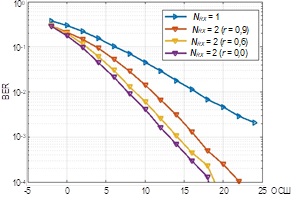
Antenna Diversity of Wi-Fi Signals Using a Switched Antenna Array
https://doi.org/10.31854/1813-324X-2025-11-1-53-61
EDN: DHIQLJ
Abstract
Relevance. The active use of wireless technologies requires the development of controls for wireless networks, in particular Wi-Fi networks. Radio monitoring services solve the tasks of detecting, identifying and localizing unauthorized access points and clients. An effective tool for bearing radio signals is correlation interferometric direction finders based on two-channel receiving equipment and a multi-element antenna system. The development of methods of joint identification and bearing makes it possible to separate the bearings of a large number of signal sources operating in the same frequency range with time division. In this work, the emphasis is placed on the detection of target signals and the identification of source features from them. The indicators of the quality of bearing will also significantly depend on the success of these operations.
The aim of the work is to investigate the possibilities of increasing the interference resistance of detecting and identifying Wi-Fi signals through the combined use of two channels of a correlation interferometric detector.
Methods. The paper uses statistical computer modeling methods that take into account the presence of fading due to multipath propagation channel and the correlation of radio signals caused by the proximity of receiving antennas.
Decision. Algorithms of detection, time-frequency synchronization and demodulation of Wi-Fi signals are considered. Methods of combining receiving channels in signal processing are proposed. The noise immunity of the proposed two-channel signal processing algorithms in the presence of quasi-stationary Relay fades and correlation of receiving channels is investigated.
Novelty. Algorithms for two-channel detection, time-frequency synchronization and demodulation of Wi-Fi signals have been developed.
Practical significance. The combined use of two reception channels for the detection and identification of Wi-Fi signals allows you to increase the reliability of radio monitoring systems by 4‒7 dB, even if there is a correlation between the channels.
About the Authors
I. S. FaustovRussian Federation
V. B. Manelis
Russian Federation
V. A. Kozmin
Russian Federation
A. B. Tokarev
Russian Federation
References
1. Ashihmin A.V., Koz'min V.A., Myakinin I.S., Radchenko D.S. Spazhakin M.I. Address bearing and location determination of radio sources with a manual direction finder. Spectekhnika i svyaz'. 2016;(4):101‒105. (in Russ.)
2. Alekseev P.A., Kozmin V.A., Kryzhko I.B., Sladkih V.A. Determining the parameters of Wi-Fi networks and access points. Spectekhnika i svyaz'. 2016;(4):29‒36. (in Russ.)
3. Faustov I.S., Sladkikh V.A., Tokarev A.B., Koshcheev E.V. Detection and analysis of Wi-Fi signals for address direction finding. Radiotekhnika. 2023;87(7):89−100. (in Russ.) DOI:10.18127/j00338486-202307-10. EDN:HCSNXO
4. Faustov I.S., Ashihmin A.V., Tokarev A.B. Address direction finding of Wi-Fi signals. Proceedings of the XXIXth International Scientific and Technical Conference on the 70th Anniversary of the Department of Radiophysics of the Voronezh State University on Raradiolocation, Navigation, Communication, 18‒20 April 2023, Voronezh, Russian Federation. Voronezh: Voronezh State University Publ.; 2023. p.56‒64 (in Russ.) EDN:MGRBOI
5. Rembovsky A.M., Ashikhmin A.V., Kozmin V.A., Smolskiy S.M. Radio Monitoring. Automated Systems and Their Components. Springer; 2018. 467 p. DOI:10.1007/978-3-319-74277-9
6. Nosov V.I. Methods for increasing the noise immunity of radio communication systems using MIMO technology and spatiotemporal signal processing. Siberian State University of Telecommunications and Informatics Publ.; 2014. 316 p. (in Russ.). EDN:VRTAXT
7. Pankratov D.Yu. Analysis of the capacity of MIMO system radio channel in conditions of spatially correlated fading. T-Comm. 2014;8(10):72‒74. (in Russ.) EDN:SZZOVL
8. Cho Y.S., Kim J., Yang W.Y., Kang C.G. MIMO-OFDM Wireless Communications with MATLAB. John Wiley & Sons; 2010. 439 p. DOI:10.1002/9780470825631. EDN:SRQIDH
9. IEEE Std 802.11a. IEEE Standard for Information technology. Telecommunications and information exchange between systems. Local and metropolitan area networks. Specific requirements. Part 11. Wireless LAN Medium Access Control (MAC) and Physical Layer (PHY) specifications: High speed Physical Layer in the 5 GHz band. 1999. 82 p. DOI:10.1109/IEEESTD.1999.90606
10. IEEE Std 802.11n. 2009. IEEE Standard for Information technology. Local and metropolitan area networks. Specific requirements. Part 11. Wireless LAN Medium Access Control (MAC) and Physical Layer (PHY) Specifications Amendment 5: Enhancements for Higher Throughput. 502 p. DOI:10.1109/IEEESTD.2009.5307322
11. IEEE Std 802.11ac. IEEE Standard for Information technology. Telecommunications and information exchange between systems. Local and metropolitan area networks. Specific requirements. Part 11. Wireless LAN Medium Access Control (MAC) and Physical Layer (PHY) Specifications. Amendment 4: Enhancements for Very High Throughput for Operation in Bands below 6 GHz. 2013. 395 p. DOI:10.1109/IEEESTD.2013.7797535
12. IEEE Std 802.11ax. IEEE Standard for Information Technology. Telecommunications and Information Exchange between Systems Local and Metropolitan Area Networks. Specific Requirements. Part 11. Wireless LAN Medium Access Control (MAC) and Physical Layer (PHY) Specifications Amendment 1: Enhancements for High-Efficiency WLAN. 2021. 766 p. DOI:10.1109/IEEESTD.2021.9442429
13. Awad M.M., Seddik K.G., Elezabi A. Channel Estimation and Tracking Algorithms for Vehicle to Vehicle Communications. Proceedings of the 82nd Vehicular Technology Conference, VTC2015-Fall, 06‒09 September 2015, Boston, USA. IEEE; 2015. DOI:10.1109/VTCFall.2015.7390864
14. Mahmoud H.M., Mousa A.S., Saleem R. Channel Estimation Based in Comb-Type Pilots Arrangement for OFDM System over Time Varying Channel. Journal of Networks. 2010;5(7):772‒776. DOI:10.4304/jnw.5.7.766-772
15. Kuang L., Ni Z., Lu J., Zheng J. A time-frequency decision-feedback loop for carrier frequency offset tracking in OFDM Systems. IEEE Transactions on Wireless Communications. 2005;4(2):367‒373. DOI:10.1109/TWC.2004.842955
16. Jimenez V.P.G., Garcia M.J.F.-G., Serrano F.J.G., Armada A.G. Design and implementation of synchronization and AGC for OFDM-based WLAN receivers. IEEE Transactions on Consumer Electronics. 2004;50(4):1016‒1025. DOI:10.1109/TCE.2004.1362493
17. Wang Q., Xie Q., Wang Z., Chen S., Hanzo L. A Universal Low-Complexity Symbol-to-Bit Soft Demapper. IEEE Transactions on Vehicular Technology. 2014;63(1):119‒130. DOI:10.1109/TVT.2013.2272640
Review
For citations:
Faustov I.S., Manelis V.B., Kozmin V.A., Tokarev A.B. Antenna Diversity of Wi-Fi Signals Using a Switched Antenna Array. Proceedings of Telecommunication Universities. 2025;11(1):53-61. (In Russ.) https://doi.org/10.31854/1813-324X-2025-11-1-53-61. EDN: DHIQLJ


































